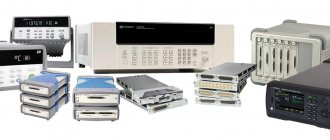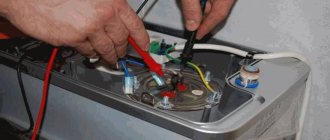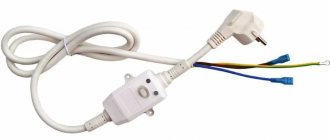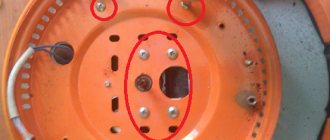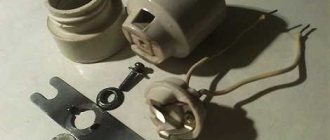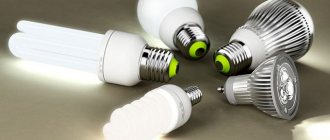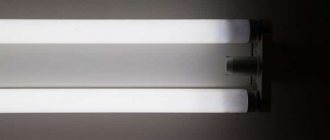Engine diagram
For a more visual understanding of the operating principle of a commutator motor, there are two visual types of representation - simplified and detailed.
The first format (Figure below) is a conventional diagram, focusing on connecting the windings to the network
More complex designs (Fig. below) have additional taps on the rotor and stator. For example, to power automation or regulate speed. The presence of thermal protection allows you to minimize the likelihood of overheating of the upper layer of the unit winding. This element removes voltage when the relay is activated, stopping the operation of the shaft.
The tachogenerator reflects the rotation speed of the engine. As an alternative, a Hall sensor is installed on some models. The device receives signals through the contacts of the collector panels.
Sparking DC machine brushes
Repair of electric motors in the cities: Moscow, St. Petersburg, Yekaterinburg, Novosibirsk, Samara, Chelyabinsk, Perm, Kazan, Krasnoyarsk
Brush sparking can be caused by a variety of causes that require maintenance personnel to closely monitor the sliding contact and brush system. The main reasons include mechanical (mechanical sparking) and electromagnetic (electromagnetic sparking).
The mechanical reasons that caused the sparking do not depend on the load. Brush sparking can be reduced by increasing or decreasing the pressure on the brushes and, if possible, decreasing the peripheral speed.
With mechanical sparking, green sparks spread across the entire width of the brush, the burn of the commutator is not regular, it is disordered.
Mechanical sparking of brushes is caused by: local or general beating, scuffing on the sliding surface of the commutator, scratches, protruding mica, poor commutator tracking (cutting mica between the commutator plates), tight or weak fit of brushes in brush holder holders, flexibility of brackets causing vibration of brushes, vibration of machines and etc.
The electromagnetic causes that cause brushes to spark are more difficult to identify. Sparking caused by electromagnetic phenomena varies proportionally to the load and depends little on the rotation speed.
Electromagnetic sparking is usually blue-white in color. The shape of the sparks is spherical or drop-shaped. The burning of the collector plates is of a natural nature, by which the cause of the sparking can be determined.
If a short circuit occurs in the winding and equalizers, the soldering is broken or a direct break occurs, the sparking will be uneven under the brushes, and the burnt plates will be located along the commutator at a distance of one pole division.
If the brushes under the bracket of one pole spark more than under the brackets of the other poles, it means that a turn or short circuit has occurred in the windings of individual main or additional poles; The brushes are incorrectly positioned or their width is larger than permissible.
In addition, additional disturbances may be observed in DC machines: displacement of the brush cross-arm from the neutral causes sparking and heating of the brushes and commutator; deformation of the sliding surface of the commutator causes vibration and sparking of the brushes; non-symmetry of the magnetic field causes a decrease in the threshold of the reactive emf, deteriorates the switching ability of the machine, which, in turn, causes sparking of the brushes.
The magnetic field of the machine is symmetrical if the correct circumferential pitch between the tips of the main and additional poles is strictly observed and the calculated gaps under the poles are maintained.
Why do brushes spark in an electric motor?
Sparks, including on a working engine, appear due to mechanical action between the brushes and the commutator.
The brush, moving along the commutator from one of its contacts to another, alternately forms and breaks a connection with each of them.
Now remember what happens if you unplug any working electrical appliance from the socket - usually at such a moment a spark jumps between the plug and the socket. In the case of a brushed motor, this is the same phenomenon.
Therefore, a small spark even on a working electric motor is acceptable, since connections and ruptures constantly occur here.
Causes of sparks and arcs
Before we look at why contacts spark, let's understand the basic concepts. The switching device and its contact system must provide a reliable connection with the possibility of breaking it at any time. The contacts consist of two electrical plates, which in the closed position must be securely pressed against each other.
An arc occurs when switching inductive circuits. These include various electric motors and solenoids, but it is worth remembering that even a straight piece of wire has a certain inductance, and the longer it is, the greater it is. At the same time, the current in the inductance cannot stop instantly - this is described in the laws of commutation. Therefore, a self-inductive emf is formed at the terminals of the inductive load, its value is described by the formula:
E=L*dI/dt
Interesting! In our case, the rate of change of current plays an important role. When turned off, it is extremely high, and accordingly the EMF will tend to large values, up to tens of kilovolts (for example, a car ignition system).
As a result, the EMF increases to such an extent that its value breaks the gap between the contacts - an electric arc or spark is formed. The quality of any connections is described by their contact resistance: the lower, the better the connection and the less heating. When they open, it increases sharply and tends to infinity. At the same moment, the area of their contact heats up.
In addition, between the open contacts against the background of increasing self-induction EMF and increased air temperature due to heating of the surfaces when the plates are opened, air ionization occurs. As a result, all the conditions for arcing and sparking are present.
If we talk about why contacts spark when an electrical circuit is closed, then this happens not with an inductive load, but with a capacitive load. You see this every time you plug in your laptop or phone charger. The fact is that the discharged capacitance (capacitor) at the input of the device at the initial moment of time represents a short-circuited section of the circuit, the current of which decreases as it is charged.
If you observe sparking in a relay or switch in the closed position, the reason for this is the poor condition of the contact surfaces and their high contact resistance.
Why do brushes spark in an electric motor, what does this phenomenon lead to and how can it be eliminated.
Topic: what to do if the brushes in an electric motor spark strongly.
So, from the beginning I will say that the sparking itself during the operation of collector electric machines is normal, only it should be very small, barely noticeable to the eye. It’s not normal when the electric motor is running and sparks fly out from its brushes - that’s bad. The very phenomenon of spark formation is associated with intermittent electrical contact that occurs during the rotation of the armature, at the moment of mechanical transition of the brush from one contact, on the commutator, to another. At this time, the circuit breaks and the current flowing through the armature coils ends its passage with a spark, a small arc discharge. Therefore, the greater the power and current in the circuit, the more noticeable the spark will be. But besides this, there are other factors that contribute to an increase in spark.
You should also pay attention to the condition of the gaps between the contacts on the collector. It often happens that they are clogged with graphite dust, which is a conductor with a certain resistance. Naturally, if these gaps are dirty, then you also put them in order (clean them with a sharp tool)
Don’t forget to check the condition of the brushes, their performance, clamping force, and freedom of vertical movement. If problems are identified with the brushes, be sure to fix them. Please note that when replacing graphite brushes, you should take into account that they are different. In this case, try to find exactly the same type as the old ones.
Naturally, if these gaps are dirty, then you also put them in order (clean them with a sharp tool). Don’t forget to check the condition of the brushes, their performance, clamping force, and freedom of vertical movement. If problems are identified with the brushes, be sure to fix them.
Please note that when replacing graphite brushes, you should take into account that they are different. In this case, try to find exactly the same type as the old ones.
The armature should be checked in an alternating electromagnetic field. If there are short-circuited turns, then in such a field the armature will begin to rattle, since induced currents will begin to form in it. To do this, you can make a homemade device from a power transformer, first making a wedge-shaped cutout on its core, into which you need to insert an armature for testing.
PS
Since this is important, I repeat once again - increased spark formation during operation of the electric motor affects its service life. In this case, strong carbon deposits quickly appear on the contacts of the collector, which after a while will damage the electrical equipment. It’s better to eliminate sparks right away than to replace the whole armature later.
It is better to eliminate the sparks immediately than to replace the entire armature later.
Design features Why brushes spark
When the engine is running, there is constant friction of the brushes against the contact plates of the commutator, which requires periodic inspection.
A slight layer of coal dust appears on the working surfaces of copper pads, as shown in the photograph.
This is due to material consumption and brush wear. This process always occurs when a commutator engine is running. Even with normal sliding of the brush, a slight break in the electrical current circuit is created. And this is always associated with sparking due to the occurrence of transient processes and the appearance of microscopic arcs. In addition, the windings have high inductive reactance. Therefore, a fully operational brush mechanism sparks during normal operation, which is not noticeable to the naked eye, but is felt by sensitive electronic devices: televisions, computers and other equipment. Noise suppression filters are always installed in their power supply circuit.
Check brush wear
The main method involves visual inspection. On the Internet you can find advice that recommends pressing the brush with a screwdriver while the engine is running and assessing the change in rotor speed. This is a dangerous operation that can only be performed by trained and experienced personnel because: it is necessary to use protective equipment: the work is carried out under voltage; there is a possibility of creating a short circuit, because you will have to check both brushes in turn
or at the same time and use screwdrivers with insulated shafts and tips. If an external inspection shows that the length of the brush is greatly reduced or the working surface is chipped, then it simply needs to be replaced.
Replacing brushes in a washing machine
Replacing brushes in a washing machine is a relatively simple task if you already have experience repairing motors in household appliances. Today you can buy new brushes both in specialized stores and online. The main thing is to choose brushes that are suitable specifically for your model of machine. It is also worth taking original components for replacement to be sure that the new brushes will last as long or even longer than the previous ones.
The washing machine will need to be disconnected from the power supply, and if the design requires it, then the hoses will need to be disconnected. The engine will have to be completely removed, untwisted and the brush rod inspected. The length of the spent rod is usually less than 1.5 cm, and if you see that the remaining part of the brush is longer, then the problem lies in another element of the machine.
After replacing parts, you need to do a test run of any washing mode. If installation is successful, the drum will rotate normally, without any extraneous knocking or grinding noise.
However, if you have even the slightest doubt about your ability to disassemble and then correctly assemble the car and its engine, then it is better not to risk it. Contact the service center for help so that in addition to the main breakdown, the technician does not have to eliminate the consequences of your inept intervention.
The average owner of household appliances thinks little about what elements and parts the equipment consists of, what problems and malfunctions can arise if used incorrectly, and what problems arise without human presence. Therefore, when hearing the term washing machine brushes, many will think of an item designed to care for and clean the unit. But this element is the most important for the life and functioning of the machine. In this article we will tell you what function brushes perform, how to find out if the brushes for electric motors of washing machines are worn out, and how to replace them.
Replacing brushes yourself or at a service center
What to do when a hammer drill fails, each master decides for himself. You can use the services of a service center and fix the problem there.
Important! If the hammer drill is still under manufacturer's warranty, it would be reasonable to have it repaired at a service center.
- Professionally done work.
- Use of original parts corresponding to the instrument model.
- Availability of warranty service.
- Complete inspection of tool components, cleaning and lubrication.
In this case, you need to be prepared for the following repair features at the service center:
Therefore, those craftsmen who prefer to save time and money replace the brushes themselves. The algorithm will tell you how to repair a hammer drill that is sparking due to worn parts:
- in a de-energized instrument, unscrew the screws and remove the top cover;
- carefully remove the brush holder and remove worn parts;
- New brushes are fixed in the holder, pressed against the edges and installed in their original place;
- close the lid and screw the screws into place.
Important! To ensure trouble-free operation of the rotary hammer when replacing the brushes, it is important to check that they reach the contacts.
What kind of lighting do you prefer?
Built-in Chandelier
How to fix and what to do if the vacuum cleaner motor brushes spark
If the household unit begins to work worse, and standard cleaning of blockages does not bring results, it is necessary, first of all, to disassemble the engine. What to do if the vacuum cleaner motor sparks depends on the type of problem.
How to replace worn brushes
Most often, the vacuum cleaner engine sparks in the area of the brushes precisely because of the natural wear of the latter. Although modern models have special capacitors that slow down abrasion, sooner or later contact between the elements leads to unpleasant problems.
Worn parts need to be replaced. To remove them, you need to remove the back cover of the vacuum cleaner, find the brush holders and pull the latches with your hands or a screwdriver. Then all that remains is to purchase exactly the same elements.
Old brushes can wear down to the springs
In order not to make a mistake with your choice, you can go to the store with the old removed parts and, with the help of a consultant, buy similar ones. Then they are installed in the old place, secured with latches and the vacuum cleaner is assembled in the reverse order.
How to eliminate poor contact of new brushes
If the vacuum cleaner is completely new, or the brushes have recently been replaced, and the motor still sparks, the reason may be a poor fit to the commutator. The problem can be solved quite simply. The engine compartment is opened, the engine is removed and the protective casing is removed from it.
It is necessary to polish the vacuum cleaner brushes with the finest abrasive.
It is necessary to go over the installed brushes with sandpaper to eliminate the smallest roughness. You can also use abrasive sandpaper to treat the collector plates if they have scratches. The smoother the contacting surfaces are, the less likely it is that the vacuum cleaner will start sparking.
How to change the angle of the brushes
If the brushes are skewed relative to the commutator after prolonged use of the vacuum cleaner, sparks will occur when the engine operates. To resolve the problem you must:
- remove the motor from the vacuum cleaner;
- visually determine how correctly the brushes are positioned relative to the commutator axis;
- Use a screwdriver to tighten the two screws securing the brush holder to align the elements.
In old vacuum cleaners, you need to carefully examine the condition of the connecting nodes between the collector and brushes. If traces of corrosion and even cracks are visible on them, such elements must be replaced with new ones.
When the axis is knocked down, the brushes begin to contact the commutator loosely
How to clean dirt
Coal dust and the resulting carbon impair the friction between the brushes and commutator and cause the engine to spark. The problem can be resolved by regular cleaning. The motor is removed from the unit and the casing is removed, after which the brushes are disconnected and access to the commutator is opened. If dirt is noticeable on the surface of the parts, they are treated with fine sandpaper until completely clean.
Plaque accumulates on the brushes and commutator, so when cleaning they are additionally degreased with alcohol. Tip! During operation, you should pay attention to the rotor contacts. If graphite dust and dirt have also accumulated between them, it must be carefully cleaned out.
How to eliminate a short circuit in the winding
Sometimes replacing brushes and other actions do not produce any results, and the vacuum cleaner continues to spark strongly. Usually the problem is an interturn short circuit of the commutator. There are two ways out of the situation - you need to either completely change the winding or replace the unit’s motor.
When a short circuit occurs, noticeable blackening appears on the collector plates
Rewinding an armature requires some experience and specialized knowledge in electrical engineering. Therefore, it is easier to send the engine for service or immediately purchase a new engine. This will be expensive, but buying just an anchor usually doesn't make sense. Its price is about 80% of the cost of the entire motor.
Potential sparking
Under certain conditions, spark discharges occur between individual collector plates on the free surface of the collector not occupied by brushes. Such sparking is called potential . It is caused either by the accumulation of coal dust and dirt in the grooves between adjacent commutator plates, or by the development of excessive stresses between adjacent plates. Such sparking is dangerous because it can develop into a short circuit between the plates and into a so-called circular fire.
Peculiarities
Electricity is supplied to the armature windings of the electric motor using a commutator unit. During operation of the apparatus, the armature rotates, contact appears, the number of revolutions is quite large, this leads to strong friction. The brushes form a “sliding” contact that converts mechanics into electrical energy. Their main task is to remove and supply current to the collectors. Electric current is also removed from the slip rings. The main thing is that the brushes are installed correctly. The kit includes tips with wires aimed at a high-quality fastening mechanism of the bolts located on the brushes.
There are different types:
- graphite – aimed at simple switching, consisting of graphite;
- carbon-graphite - characterized by weak strength, they are often used on equipment with minimal loads;
- electro-graphite – are high-strength, withstand medium contact conditions;
- copper-graphite - have good strength, have strong protection that protects against gases, as well as various liquids.
There are also improved models of brushes in a plastic case. In appearance, they are no different from the above, only they have protection in the form of a housing or a plastic shell.
Reasons why brushes spark
Very often you can notice how the brushes on an angle grinder sparkle. Signs of sparking are detected through the ventilation holes in the body of the power tool. Craftsmen are interested in why the brushes on an angle grinder spark, even after they have been directly replaced. There are many reasons for this, and to understand this, you need to have an understanding of the structure of a power tool. If you know how the angle grinder works inside, then understanding why the brushes spark strongly will not be difficult.
The reasons for strong sparking of brushes on grinders are the following factors:
- Faulty armature winding. If a violation of the insulation of the armature winding occurs, then this ultimately contributes to the development of an interturn short circuit, as well as a short circuit to the core. In addition, a winding break may occur, which will ultimately cause an increase in load. A characteristic sign of a faulty armature winding is a decrease in speed, an increase in noise and a drop in power
- The brushes do not press well to the commutator. A spring is responsible for pressing the main part, which, over time, loses its original springing properties.
- The rotor winding has broken off from the copper plate of the commutator - this phenomenon is extremely rare, however, if the power tool is overloaded, it may well occur
- The centering of the electric motor armature is disrupted, which ultimately contributes to strong sparking of the brush on the angle grinder
- The shape of the collector is broken. The collector, consisting of copper lamellas, has a cylindrical shape, which can be broken when the rotor is rewinding. At the slightest deformation of the commutator shape, sparking of the brushes will occur
- Violation of insulation between the collector lamellas. Each collector plate is insulated from each other, and if the micanite insulating layer is damaged, sparking occurs. The insulation between the plates may also be compromised due to the settling of the graphite layer in the grooves
- When the armature bearings are worn. If the bearings are faulty, then a beating of the rotating armature occurs, and as a result, signs of sparking appear
- Curvature of the rotor shaft. It is difficult to bend it, but if this happens, the engine begins to work under load. To prevent the tool from malfunctioning, it is recommended to replace the rotor
- If the ends of the armature windings are soldered incorrectly to the copper plates of the collector. Such errors are not allowed at the factory, but they can be made by the wrapper who rewinds the armature of the power tool.
- Inappropriate composition of graphite brushes. The parts in question are made from coal and graphite, adding different types of impurities. This is done for a reason, but in order to use brushes depending on the voltage and shaft rotation speed. Graphite can be soft or hard. The lower the supply voltage, the softer the grade of graphite selected. For high-voltage power tools, it is necessary to take hard brushes that do not contain copper.
- Deformation of the lamellas due to their heating. If the angle grinder experiences excessive loads, deformation of one or more lamellas of the collector may occur. The plates rise relative to the others, resulting in the contact being broken. This malfunction causes strong sparking of the brushes when operating the power tool.
- Poor contact at the brush connection point. If the terminal is loosely connected to the device, the result of this contact failure may manifest itself in the form of excessive sparking
- Presence of carbon deposits on copper plates - periodically or regularly it is recommended to clean the surface of copper lamellas from carbon deposits. Carbon deposits usually appear due to wear of the brushes, so if blackening is detected on the surface of the commutator, it should be wiped with alcohol
Often, after changing the brushes on an angle grinder, craftsmen observe the phenomenon of excessive sparking. Based on the factors described above, you can identify the cause and eliminate it before the tool fails. The elements in question are inexpensive, but due to their incorrect selection and use, the power tool may break. To find out what malfunction is causing strong sparking, you will need to disassemble the power tool and inspect it, as well as ring the rotor winding.
Why do brushes burn out on angle grinders?
In addition to sparking, power tool owners often encounter brushes on their grinders burning. This phenomenon differs from sparking in that rapid wear of the main part of the element occurs. Immediately after installing new elements, they wear out immediately when using the power tool for the first time. We have to figure out why the brushes on the grinder burn.
The main reason lies not in the brushes themselves, but in the commutator. If the lamellas fall out or wear out on the collectors, this leads to an increase in load. This load is experienced by graphite elements, which, when the angle grinder is turned on, begin to wear out quickly - this process of accelerated wear is called combustion. Elements literally burn due to the passage of large current. Many people call this process abrasion, but in reality brushes cannot quickly wear out due to mechanical stress. The cause of combustion is strong sparking, as a result of which the graphite literally simply burns out.
The reasons why brushes on an angle grinder burn are as follows:
- Loss or wear of the copper lamellas of the collector. What wear on the collector lamellas looks like is shown in the video. The material also shows how you can try to eliminate such a malfunction.
There is also such a thing as all-round fire. This phenomenon occurs during large impulses of the armature current, for example, during overloads, short circuits, and also when the network voltage decreases. A circular fire appears when the arc is re-ignited. An increase in load and even a short circuit occurs when using an angle grinder to cut wood. When processing wood, the cutting disc becomes clamped, thereby increasing the current by 15-25 times the nominal value. Most often, the commutator is the cause of element combustion, so if you had to change 2-3 pairs of brushes in a month, then it’s time to diagnose the power tool.
Changing the angle of inclination
If the angle of inclination of the brushes relative to the stator is incorrect, sparking may also occur. The correct position is when both brushes are strictly on the same line passing through the axis of rotation of the commutator. Over time, due to constant vibration, the brush holder mount may become loose or even suffer mechanical damage. Carefully inspect the surfaces of the components. Parts that have cracks, chips or signs of corrosion must be replaced.
Each manufacturer introduces design features into its product line, and therefore different types of vacuum cleaners have different types of brush attachment. However, in general, all models have the same device, and the brush holder is usually screwed on with two screws and allows for adjustment.
Grooving with sandpaper
The armature shaft is fixed in the chuck of some torque mechanism (lathe, drill). The rotation starts and the abrasive is applied to the commutator. Avoid forceful pressure and the use of coarse sandpaper. The minimum grain size is 1000 P.
Using a multimeter, detect the presence of a breakdown in the armature winding. Set resistance test mode. Place one probe on the lamella and the other on the contact of the corresponding winding route. The absence of an open circuit will be indicated by an audible signal. If there is no signal, this route is broken. You will need to replace the armature or rewind its winding.
Determine whether there is any runout in the bearings. If it is found, replace the bearings and measure with a micrometer the diameter of the edges of the armature shaft in the places where it adjoins the assemblies.
What are they made from?
Brushes for grinders and other power tools are made from different materials, but the main ones are coal and graphite. This material has a low coefficient of friction and also has increased abrasion resistance. To improve contact, various impurities are added to the composition of graphite or carbon during the manufacture of brushes. Depending on the impurities used, the following types of brushes are distinguished:
- Coal
- Copper plated
- Carbon-graphite
- Graphite
- Copper-coal
- Copper-graphite
The composition of the main part affects not only the service life or wear, but also such a parameter as signs of sparking. The amount of brush sparking depends on the composition from which they are made
When purchasing them, you need to pay attention to the composition, and not purchase equipment of unknown origin and questionable quality.
This is interesting! The design of the brushes contains a ceramic tip, which performs one of the important tasks. When the graphite layer is abraded to the limit, the tip begins to contact the copper lamellas of the commutator. Ceramics do not conduct electricity, so when the brushes wear out, the grinder will work intermittently or will not turn on at all until the devices are replaced.
What are they made from?
Brushes for grinders and other power tools are made from different materials, but the main ones are coal and graphite. This material has a low coefficient of friction and also has increased abrasion resistance. To improve contact, various impurities are added to the composition of graphite or carbon during the manufacture of brushes. Depending on the impurities used, the following types of brushes are distinguished:
- Coal
- Copper plated
- Carbon-graphite
- Graphite
- Copper-coal
- Copper-graphite
The composition of the main part affects not only the service life or wear, but also such a parameter as signs of sparking. The amount of brush sparking depends on the composition from which they are made
When purchasing them, you need to pay attention to the composition, and not purchase equipment of unknown origin and questionable quality.
This is interesting! The design of the brushes contains a ceramic tip, which performs one of the important tasks. When the graphite layer is abraded to the limit, the tip begins to contact the copper lamellas of the commutator. Ceramics do not conduct electricity, so when the brushes wear out, the grinder will work intermittently or will not turn on at all until the devices are replaced.
Reasons why brushes spark
Very often you can notice how the brushes on an angle grinder sparkle. Signs of sparking are detected through the ventilation holes in the body of the power tool. Craftsmen are interested in why the brushes on an angle grinder spark, even after they have been directly replaced. There are many reasons for this, and to understand this, you need to have an understanding of the structure of a power tool. If you know how the angle grinder works inside, then understanding why the brushes spark strongly will not be difficult.
https://youtube.com/watch?v=W-k9JyxuWik%3F
The reasons for strong sparking of brushes on grinders are the following factors:
- Faulty armature winding. If a violation of the insulation of the armature winding occurs, then this ultimately contributes to the development of an interturn short circuit, as well as a short circuit to the core. In addition, a winding break may occur, which will ultimately cause an increase in load. A characteristic sign of a faulty armature winding is a decrease in speed, an increase in noise and a drop in power
- The brushes do not press well to the commutator. A spring is responsible for pressing the main part, which, over time, loses its original springing properties.
- The rotor winding has broken off from the copper plate of the commutator - this phenomenon is extremely rare, however, if the power tool is overloaded, it may well occur
- The centering of the electric motor armature is disrupted, which ultimately contributes to strong sparking of the brush on the angle grinder
- The shape of the collector is broken. The collector, consisting of copper lamellas, has a cylindrical shape, which can be broken when the rotor is rewinding. At the slightest deformation of the commutator shape, sparking of the brushes will occur
- Violation of insulation between the collector lamellas. Each collector plate is insulated from each other, and if the micanite insulating layer is damaged, sparking occurs. The insulation between the plates may also be compromised due to the settling of the graphite layer in the grooves
- When the armature bearings are worn. If the bearings are faulty, then a beating of the rotating armature occurs, and as a result, signs of sparking appear
- Curvature of the rotor shaft. It is difficult to bend it, but if this happens, the engine begins to work under load. To prevent the tool from malfunctioning, it is recommended to replace the rotor
- If the ends of the armature windings are soldered incorrectly to the copper plates of the collector. Such errors are not allowed at the factory, but they can be made by the wrapper who rewinds the armature of the power tool.
- Inappropriate composition of graphite brushes. The parts in question are made from coal and graphite, adding different types of impurities. This is done for a reason, but in order to use brushes depending on the voltage and shaft rotation speed. Graphite can be soft or hard. The lower the supply voltage, the softer the grade of graphite selected. For high-voltage power tools, it is necessary to take hard brushes that do not contain copper.
- Deformation of the lamellas due to their heating. If the angle grinder experiences excessive loads, deformation of one or more lamellas of the collector may occur. The plates rise relative to the others, resulting in the contact being broken. This malfunction causes strong sparking of the brushes when operating the power tool.
- Poor contact at the brush connection point. If the terminal is loosely connected to the device, the result of this contact failure may manifest itself in the form of excessive sparking
- Presence of carbon deposits on copper plates - periodically or regularly it is recommended to clean the surface of copper lamellas from carbon deposits. Carbon deposits usually appear due to wear of the brushes, so if blackening is detected on the surface of the commutator, it should be wiped with alcohol
Often, after changing the brushes on an angle grinder, craftsmen observe the phenomenon of excessive sparking. Based on the factors described above, you can identify the cause and eliminate it before the tool fails. The elements in question are inexpensive, but due to their incorrect selection and use, the power tool may break. To find out what malfunction is causing strong sparking, you will need to disassemble the power tool and inspect it, as well as ring the rotor winding.
https://youtube.com/watch?v=JhnK8Mi2syY%3F
How to understand that you need to change the brushes
Many people change brushes only after they notice strong sparking from the tool, as well as the appearance of a burning smell. Many craftsmen are not stopped even by these signs, and they continue to use the tool until it stops turning on. When is it necessary to change carbon brushes so as not to damage the structure of the power tool? There are the following signs for this:
- Strong sparking - if signs of strong sparking appear, then it is necessary to disassemble the tool and inspect the consumables. Sparking is the first sign that consumables need to be replaced.
- The appearance of a burning smell - if the smell of soot is heard when using the tool, it is recommended to disassemble the grinder and replace the graphite brushes
- When the wear of the main part is over 30% -40%. However, it is almost impossible to determine their initial length, unless you measure it before installing the elements
- When signs such as jerking or “growling” of the power tool appear
Devices are also subject to replacement if they have uneven wear and do not correspond to quality.
This is interesting!
It is not recommended to buy copper-plated brushes for a home grinder, as they will quickly damage the armature commutator due to the high copper content in the composition.
Copper-plated elements can be used on grinders that have a special coating on the collector plates. https://youtube.com/watch?v=Wt0n_ECSwvE%3F
The drill sparks on the brushes - what to do
So, your drill sparks on the brushes and you don’t know what to do in this situation. This article will tell you why this happens, whether it needs to be fixed, and if so, how.
It is immediately worth noting that the presence of the specified sparking during operation is a completely acceptable phenomenon. This is true only if the sparks are small and there are not so many of them. If they just fall out, this may indicate a malfunction.
Note that on a new, working power tool, the brushes may also spark strongly at first, since they need to first get used to. Grinding in usually takes 10-15 minutes of work. If after this everything remains as it was, then it is better to take the instrument back to the store with a claim.
If your drill is no longer under warranty, you can try to fix it yourself.
But first we will describe the reasons for this phenomenon.
Why do brushes spark in an electric motor?
Sparks, including on a working engine, appear due to mechanical action between the brushes and the commutator. The brush, moving along the commutator from one of its contacts to another, alternately forms and breaks a connection with each of them. Now remember what happens if you unplug any working electrical appliance from the socket - usually at such a moment a spark jumps between the plug and the socket. In the case of a brushed motor, this is the same phenomenon.
Therefore, a small spark even on a working electric motor is acceptable, since connections and ruptures constantly occur here.
Causes of severe sparking and how to eliminate them
Now let's move on to strong sparking. It occurs mainly for the following reasons:
- contamination of collector contacts with carbon deposits
- graphite dust getting between the collector contacts
- interturn short circuit in the armature winding
Let's go through each point separately.
1) Soot contamination occurs as a result of engine overheating. The presence of carbon deposits leads to even more friction, which leads to even faster overheating and even more carbon deposits. Which very quickly leads to breakdown.
Excessive sparking here results from the fact that carbon deposits form additional resistance, which causes the spark to break when it breaks, becoming larger and more powerful.
In general, carbon deposits should be removed immediately.
This is done with zero grade sandpaper. That is, you need to remove the collector along with the armature and carefully clean it. Ideally, it is advisable to carry out the grinding on a lathe so as not to disturb the correctness of the circle. But, as a rule, this is not possible, so you can get by with manual stripping. The main thing is not to overdo it.
2) When using a drill, the brushes wear out, which causes the formation of graphite dust. It can easily accumulate between the collector contacts and lead to short circuits between them, since it is a conductor of electricity and has its own resistance. Because of this, the current is distributed unevenly, which leads to large sparks in some places.
In a working drill, wear occurs quite slowly, so graphite dust hardly accumulates. Accordingly, its accumulation signals that the brushes are in the wrong position during operation. This usually happens when they do not stand tightly in their groove, but, on the contrary, have some play.
This often happens when replacing brushes, when they are selected to be not quite suitable in size.
Therefore, when replacing this point, you should pay close attention.
Repair of such a malfunction is carried out by removing dust with some pointed tool and replacing the brushes with more suitable ones.
3) In the event of an interturn short circuit in the armature, the current flows in a larger value to some contacts and a smaller value to others. Because of this, more current flows in some places than necessary, resulting in large sparks.
Identifying such a short circuit should be done when the two previous points did not give much effect. It is produced using a special device that creates an alternating magnetic field. When an armature is placed in this field, it begins to rattle, as induced currents appear in it.
Some people make such a device themselves from a power transformer, in the core of which a cutout is made where the armature is placed.
If the reason turns out to be an interturn short circuit, then you need to rewind the winding or completely replace the armature.
These are the causes of excessive sparking on the drill brushes. Remember, if you don't do anything about it, the engine will most likely break down soon. Therefore, do not be lazy and follow the recommendations indicated in the article.
instrument-tehnika.ru
When sparking of commutator motor brushes is normal
The operating algorithm of the commutator motor is such that while moving, the brushes constantly come into contact with the commutator, breaking and re-closing the electrical circuit. It is precisely this operating mechanism, directly related to the design features of the commutator mechanisms, that is the inevitable cause of the appearance of sparks during its operation, even in the case when the engine is absolutely in good working order. However, it is important to understand that sparking in this case is minimal. Strong sparking, as a rule, indicates that the operation of the commutator motor is disrupted and in order to fix it, it is important to find out the cause of the malfunction.
Replacing brushes
The simplest and most obvious cause of sparks is wear on the brushes. Despite the fact that commutator motors are equipped with special spark-extinguishing capacitors, which, in addition to increasing the service life of these elements, also reduce radio interference, over time the brushes wear out and need to be replaced.
To replace the brushes, you first need to get to the electric motor. To do this you will have to disassemble the vacuum cleaner. In most cases, this is quite simple to do with a screwdriver, but do not forget to unplug the device. Having disassembled the vacuum cleaner and provided convenient access to the engine, we find the brush holders. Depending on the design, to remove the brushes from the brush holder, you usually need to pull out the latches, which may require a screwdriver.
In recent years, many manufacturers have supplied their vacuum cleaners with a set of spare brushes. But if you happen to purchase the device without additional spare parts, they can be purchased at stores that sell power tools.
Brushes are graphite and copper-graphite. It will be better if you remove the old elements from the electric motor of your vacuum cleaner in advance and go to the store with them, so as not to make a mistake in your choice.

